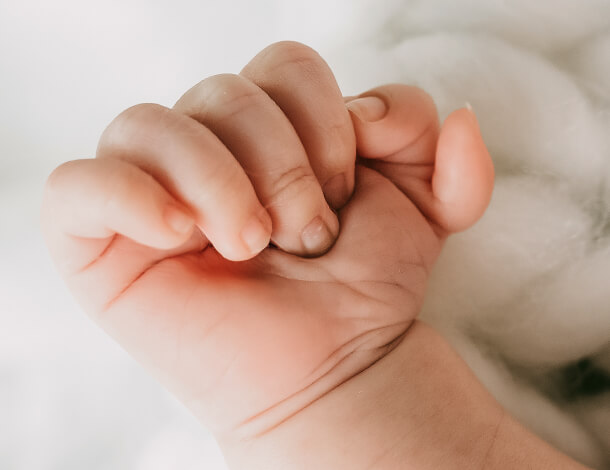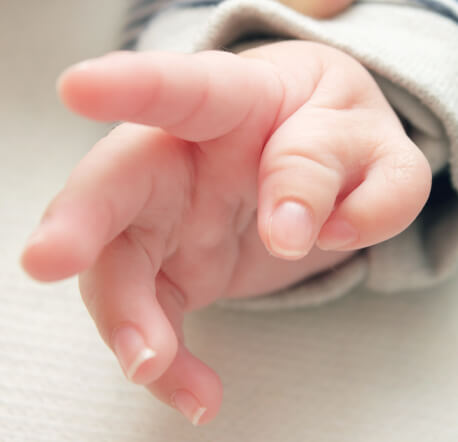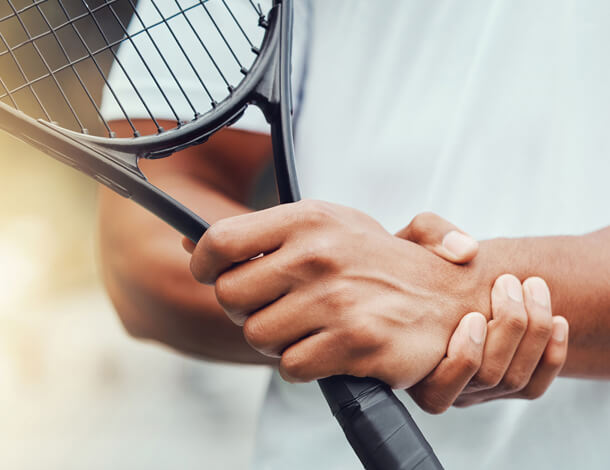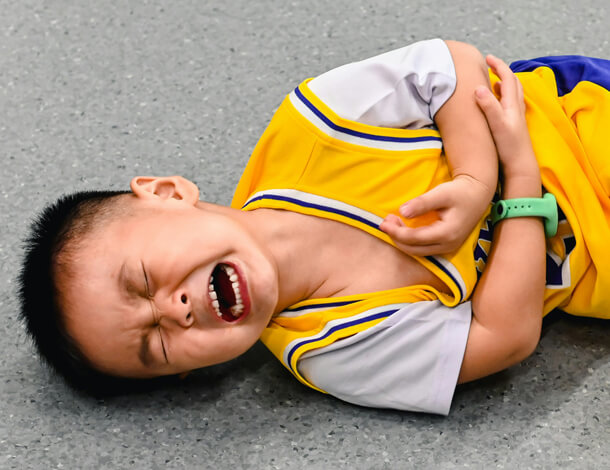Understanding Polydactyly: A Guide for Parents of Newborns With Six Fingers on One Hand

Outside of The Princess Bride, a fantasy movie that featured a character with six fingers on one hand, most people never encounter the condition. Known as polydactyly, it’s a congenital abnormality that occurs in less than 1% of live births.
It’s understandable if you’re just now learning about the condition. Since a person’s sixth digit may be removed shortly after birth, sometimes, no one outside the family knows.
In many cases, extra fingers pose no physical challenges on their own and aren’t a disability. In fact, it can even have advantages, like extra dexterity and innovative motor skills.
Despite the rarity of having six fingers on your hand, many pediatric hand specialists have seen plenty of children born with polydactyly and provide advanced care for the condition.
Read on to learn about the treatment options, likely outcomes, and how to give a child born with six fingers on one hand the highest possible quality of life.
What Is It Called When Someone Has Six Fingers on One Hand?
A hand with six fingers is a form of polydactyly, a congenital difference that can occur on the hand or foot. The digit could be either fully or partially formed, and it’s more common on the right hand than the left. It’s also called “supernumerary,” or more than the typical number.
Types of Polydactyly
There are three types of polydactyly (postaxial, preaxial, and central). Each is named for the extra digit’s location.
Postaxial
Postaxial polydactyly refers to an extra digit next to the pinky finger or the ulnar side of the hand. It’s also called small finger duplication. It’s the most common configuration when a child has six fingers on one hand, and it’s ten times more common in Black children than in White children.
Preaxial
Preaxial polydactyly refers to an extra thumb or digit on the radial side of the hand. Preaxial is also called thumb duplication.
Central
Central polydactyly refers to an extra finger in the middle of the hand. A central polydactyly is more likely to be fully developed and functional than a duplicate small finger or thumb. It’s also more complex to remove surgically. Central polydactyly occurs in only 5% to 15% of cases.
What Causes Six Fingers on One Hand?

The formation of six fingers on one hand can be passed down among family members (hereditary) or caused during pregnancy (congenital). About 30% of polydactyly cases are hereditary.
In cases of congenital formation, doctors don’t fully understand what causes the development of six fingers on one hand, but it’s believed to be a natural process. One explanation is decreased blood circulation during limb development, which occurs in weeks four to eight of pregnancy. A clot or small arteries can slow blood circulation. Genetic mutation is another cause of polydactyly.
There’s no evidence that a pregnant woman’s behavior causes a fetus to develop six fingers on one hand. However, exposure to chemicals in textile factories during pregnancy has been identified as a risk factor for fetal polydactyly.
Polydactyly tends to occur in isolation without other symptoms or conditions, but it can be associated with specific genetic syndromes, such as Ellis-van Creveld syndrome and trisomy 13.
Understanding whether the cause is hereditary or not can help doctors determine treatment.
How Common Is Six Fingers on One Hand?
Only one out of 500 to 1,000 children is born with six fingers on one hand. A duplicate pinky finger is the most common form. An extra pinky or thumb accounts for 95% of cases versus an extra middle finger which makes up 5% of polydactyly occurrences.
While it’s rare to see six fingers on one hand, one in 20 children is born with some type of hand difference. This could be webbed fingers or undersized or oversized parts.
Diagnosing Polydactyly
Polydactyly may be detected on an ultrasound during pregnancy. Most cases are visible at birth. Once the baby is born, the doctor will examine the hand to determine what type of polydactyly has occurred and may follow up with X-rays to understand the structure of the bone and tissue.
Depending on the complexity of the case, your doctor may recommend that you consult with a specialist. Look for a board-certified orthopedic hand surgeon with fellowships or experience treating similar polydactyly cases.
Genetic Counseling Benefits
Having six fingers on a hand is the most common form of hereditary limb difference. If you have a family history of polydactyly, genetic counseling can determine the likelihood of passing it along and guide treatment options if the baby develops polydactyly.
Genetic counseling helps doctors make the most accurate diagnosis and prognosis. It also provides clarity for the parents, who may be susceptible to feeling guilty if a child is born with six fingers on a hand.
With early detection of potential risk factors for future children, parents can prepare themselves for the possibility of having a child with polydactyly. It’s a good idea to seek education and support groups to deal with any feelings of shock, anger, or guilt and be ready to provide the best care for the child.
Getting Ready for Your First Hand Therapy Appointment? Here's What to Expect
Life With Six Fingers on One Hand
In many cases, a person can live a normal life with six fingers on a hand. Even though it’s technically a congenital disability, an extra finger may not present a physical problem.
In other cases, depending on the formation and functionality of the digit, the child can benefit from occupational therapy, physical therapy, and home exercises to learn to accomplish tasks with six fingers after surgery or if the extra digit isn’t removed.
If the digit isn’t removed, then parents should seek counseling or talk to their doctor if the child is experiencing psychological effects or social alienation related to the hand’s appearance.
Don’t be surprised if your child is resilient and has a healthy attitude about having six fingers A functional extra digit can feel like a superpower—for instance, with extra motor skills, a person can play an instrument or video game differently than those with five fingers.
Treatment Options

There are several remedies for children born with six fingers on a hand, depending on the severity of the case and parents’ wishes. In many cases, the extra digit can be removed before the child misses any stages of development.
Non-Surgical Removal
If the extra digit or mass isn’t attached to any bones and is composed of tissue and muscle, it might be removed in infancy with just a vascular clip. The clip cuts off blood flow to the finger, eventually causing it to fall off like an umbilical cord. However, this type of removal can leave a painful nerve stump under the skin.
Consult a hand specialist before allowing the hospital staff to tie off an extra digit or underdeveloped tissue.
Surgical Removal
Depending on the location and complexity of the extra digit, the doctor may recommend surgery immediately or give you the option to see if the digit poses any problems as the child grows. Surgery could wait several years.
Removing a pinky finger or thumb is often a straightforward procedure. Removing a middle finger can be more complex, depending on how attached the bone is to the surrounding structure. Sometimes, a second finger is removed and reconstructed to ensure the typical spacing of the fingers. Surgery can also extend to moving tendons.
Occupational Therapy
If the extra digit isn’t removed and fully functional, an occupational therapist can help the child learn how to move the fingers and hand to perform day-to-day tasks.
Book a Pediatric Hand Consultation Appointment at IHTSC
If your baby is born with six fingers on a hand, it might not have to be removed. Consult with one of the esteemed pediatric hand specialists at Indiana Hand to Shoulder Center about the best treatment plan for a child with polydactyly.
Call (317) 875-9105 to book an appointment or schedule one online.
You Might Also Like:
- How to Care for a Child With a Wrist Buckle Fracture: Tips for Parents
- Viking Fingers: Are You at Risk for This Progressive Hand Condition?
- What Actually Causes Hand Numbness and Pain?
- Nursemaid’s Elbow: When Child’s Play Ends in Pain
Medically reviewed by Kathryn Peck, MD
Disclaimer: The materials on this website have been prepared for informational purposes only and do not constitute advice. You should not act or rely upon any medical information on this website without a physician’s advice. The information contained within this website is not intended to serve as a substitution for a thorough examination from a qualified healthcare provider. The display of this information is not intended to create a health care provider-patient relationship between the Indiana Hand to Shoulder Center and you.



